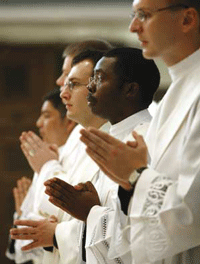Although Caucasians are still statistically overrepresented, the class of U.S. seminarians due to be ordained priests in the next couple of months shows a continuing increase in the racial and ethnic diversity of ordinands in recent years, according to data released in April by the U.S. Conference of Catholic Bishops and compiled by the Center for Applied Research in the Apostolate at Georgetown University.
The new study shows Asian-Americans represent 11 percent of this year’s ordinands—the term for those about to be ordained—even though Asian-Americans account for only 3 percent of the total U.S. Catholic population. Most of the ordinands of Asian descent were Vietnamese (6 percent of the total), or Filipino (2 percent). After years of underrepresentation, African-American Catholics have apparently regained a proportional representation among those being ordained. About 3 percent of U.S. Catholics are black, and the same percentage of this year’s ordination class is black.
Non-Hispanic Caucasians now make up only about 58 percent of the U.S. Catholic population, but they continue to constitute a larger majority of ordination classes—72 percent this year. The most underrepresented group was Hispanics. U.S. Catholics of Hispanic or Latino heritage make up an estimated 34 percent of the nation’s Catholic population. But only 12 percent of the ordinands answering the CARA survey described themselves as Hispanic.
The total annual number of U.S. ordinands has been stable for several years at around 450. But that is barely half of what would be needed to replace fully those priests leaving active ministry each year because of death, retirement, illness or other reasons. The average age of this year’s ordinands is 36, consistent with the average over the past five years. The average age at ordination in the 1950s and 60s by contrast was 26, but that gradually climbed in the next three decades. It now has apparently leveled out. Age at ordination is significant for projecting the future pool of active priests, because a man ordained at 26 might be expected to have as many as 50 years of active service, while one ordained at 36 would more likely have at most 40 years ahead of him before retiring or removal from service by illness, death or other causes.
A senior research associate at CARA, Mary L. Gautier, said that another recently completed but not yet published CARA study found that only 64 percent of the nation’s 27,614 diocesan priests are fully active. She said that study’s findings are consistent with figures from the 2008 Official Catholic Directory, which listed 8,433 of the country’s diocesan priests, or 31 percent, as retired, ill or absent on leave. Just 10 years earlier, the directory reported that there were some 4,000 more diocesan priests, but at that time only 24.6 percent of them were listed as inactive because of retirement, illness or leave of absence. Thus the number of active diocesan priests has dropped from nearly 24,000 in 1997 to a little over 19,000 in 2007.








